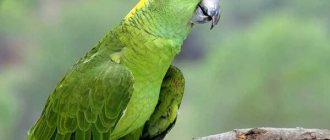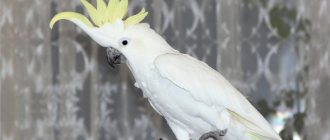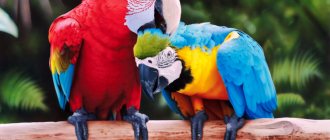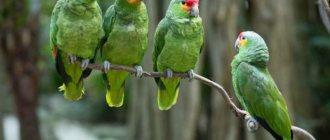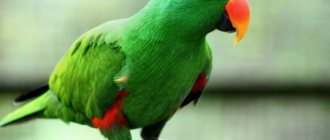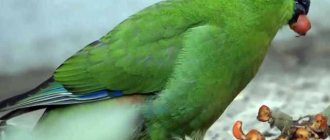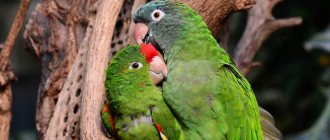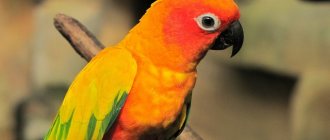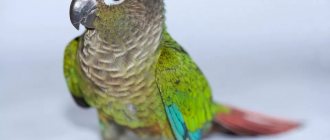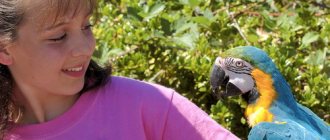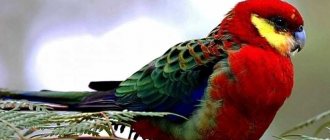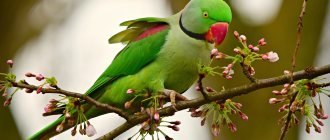Among pets, birds occupy a special place. Parrots are one of the most popular bird species to keep at home.
Amazon parrots have been known since the voyages of Columbus; they are a human companion with a long history. Amazons are smart, beautiful, love movement, noisy and have the ability to imitate human speech, feathered favorites. The cost of purchasing such a curiosity in Russia will cost from 15,000 rubles. up to 250,000 rub . The difference in price will depend on the type of Amazon, its age, and whether it is a hatchling or a wild one.
Appearance and size of the bird
Amazon parrots are in most cases large birds, with the exception of some species. Their body length varies between 25-45 cm. The average weight of birds is 350-500 g, but larger species weighing up to 700 g are found.
Amazon is a bird with bright green dense feathers. Different species may have red, yellow, blue or cyan spots on different parts of the body. The Amazon parrot's wings are small. The tail is short and rounded.
The beak is shiny and smooth, large and powerful, with a pointed rib base and a downward curved end. The Amazon's eyes are round in shape. Young parrots have gray-brown irises. After reaching the age of three, it acquires a reddish tint.
Varieties
The most famous varieties of Amazon parrots that are suitable for keeping at home:
- The Surinamese, also called the yellow-fronted Amazon, is a medium-sized parrot. The length of its body is less than 40 cm. It has green feathers all over its body, and there is a yellow spot on the frontal part of its head.
- Amazon yellow-headed is a parrot with a body length of 40-41 cm. The head and front of the neck are painted bright yellow. A dark green edging runs along the back, chest and neck. There are red blotches on the upper part of the wings. Some representatives of this species may have lemon spots on other parts of the body.
- Red-fronted Amazon. This parrot is also called the yellow-cheeked parrot. He has a bright, memorable appearance. The body is medium-sized - 34-36 cm in length, weight - 350-480 g. Males are larger than females. The red-fronted Amazon is green, there is a black edging on the back of the head, a bright red spot on the forehead, and yellow cheeks. Powerful paws are painted gray, the color of the iris is orange.
- Muller's Amazon is a large bird from the parrot family. Its body length reaches 43-45 cm, and its weight is 500-700 g. The color of the feathers is green with a light gray tint. When you look at the parrot, you get the impression that it has been sprinkled with flour. A distinctive feature of Muller's Amazon is a purple-gray edging on the back of the head. There is a lemon stain on the forehead. The iris of a parrot's eyes is chestnut-brown or red, and its paws are gray.
- The white-headed Cuban Amazon is a very beautiful medium-sized parrot: body length - 30-35 cm, weight - 350-450 g. Its peculiarity is a large white spot on the head, which extends to the frontal part, covers the eyes and reaches the top of the head. The neck, cheek area and part of the chest are colored pink-red. There is a purple spot on the parrot's belly, and the flight coverts are colored blue. The paws are brown, the iris of the eyes is brown. The tail plumage is emerald green with a bright yellow frame. It contains single red feathers.
- Blue-fronted Amazon. This is a medium sized parrot. The length of its body ranges from 35-40 cm. Weight is 400-500 g. On the upper part of the body the plumage is decorated with malachite edging. There is a blue spot on the forehead. The parietal area of the head, neck and cheeks are yellow. The parrot's beak is coal-black, its paws are gray. The feathers on the wing fold are bright red. The eye color of mature individuals is brown or reddish.
- Venezuelan Amazon. This parrot looks almost like a blue-fronted parrot, but it is a little smaller - 30-31 cm in length, its weight rarely exceeds 350 g. There are blue specks on the forehead, and there is a red stripe on the flight feathers. The beak is brownish-yellow, the tip is dark. The eyes are orange.
There are about 30 species of Amazon parrots. Of these, 18 are recorded in the Red Book. Birds of the same species from different geographical areas may differ from each other in body size and color.
Purchase: selection and price of a parrot Amazon
Yellow-headed and white-headed parrots have the calmest and most docile character. By the way, they are also seen in a greater desire than others to learn human language. Therefore, such parrots will be the best purchase option.
It would be correct to purchase a parrot from a nursery with a good reputation; they will not sell you a sick or old bird. To make sure you choose a good future companion, follow these points:
- the chick must have a ring on its paw - the date of its birth and the country where the nursery is located will be engraved on it;
- thanks to the date, you can find out the age; buying a four-month-old chick would be ideal;
- the parrot must be tame and absolutely not afraid of people;
- if the bird is not ringed, pay attention to the iris of the eyes, if it is gray-brown in color, then the bird is not yet 2-3 years old, but if it turns orange, brown or red, then the bird is completely adult and you will be able to tell how old it is impossible;
- pay attention to the feathers: they should be clean, close to the body;
- the parrot should breathe evenly and measuredly;
- shiny eyes indicate good health of the Amazon;
- but a protruding breast bone indicates illness or exhaustion of the bird.
How much do Amazon parrots cost? It all depends on the region of purchase. The prices for the most popular types of Amazon parrots are as follows:
- Blue-fronted – $500-1230;
- Cuban – $570-1000;
- Venezuelan – $500-1000;
- Muller – $450-850;
- Festival – $500-620;
- Yellowhead – $600-1200;
- Surinamese (yellow-fronted) – $550-1000;
- Red-fronted – $600-700;
- White-fronted – $370-1000.
Birds at a reduced price may not only be sick and old, but also smuggled, caught in the wild. In nurseries and from trusted breeders you will buy a fosterling that has been raised at home and is accustomed to handling.
Character and behavior
Amazon is a parrot with high intelligence and capricious character. Some species demonstrate strong affection for all members of the household, while others choose one family member as the object of adoration.
One of the characteristics of the Amazon parrot is its rapid mood swings. These birds can be capricious and even aggressive. In a bad mood, they are capable of causing serious injury, because they have a very powerful beak. Parrots of this species easily remember and imitate not only human speech, but also reproduce other sounds:
- cat meowing;
- dog's bark;
- Birdsong;
- phone ringtone;
- the sound of water;
- doorbell sound.
With regular interaction with people, the Amazon parrot's vocabulary can exceed 100 words. The blue-fronted and yellow-headed varieties are considered especially talkative.
The red-fronted Amazon often shows his dissatisfaction and is capricious. It is more difficult to find an approach to such a parrot. He usually becomes attached to one family member and dislikes others.
Attention! For those who like silence, it is better not to start an Amazon. This parrot makes noise from early morning until late evening. To prevent your pet from waking up too early, it is recommended to cover the cage with black cloth at night.
Amazons do not get along well with pets and other bird species, such as finches. Their joint content is unacceptable.
Treatment and prevention of diseases of the Venezuelan Amazon
A change in the bird’s well-being can be noticed by its unusual behavior. During illness, the parrot does not sing, does not speak, becomes lethargic, drowsy and, ruffled, sits motionless on the perch. He may develop lameness, cough, lose weight, sneeze, tremble, and lose feathers. Redness of the eyes and discoloration of the droppings are also observed.
If you do not know what to do, it is better to contact a veterinarian. But some cases require an immediate response, and it is better to prepare for them in advance. This way you can provide first aid to your ward.
- Fracture of a wing or tarsus. If you notice damage to an Amazon's leg, try putting a splint on it and immobilizing the limb, as is done for ordinary fractures. A splint is not applied to the wing, but you can wrap the parrot in a bandage or gauze, leaving the legs free to move the bird.
- Minor scratches. You should treat the cut or scratch with hydrogen peroxide and, if necessary, apply an adhesive plaster.
- Dandruff, itching, damaged feather tips. Symptoms indicate that the skin of the Venezuelan Amazon is not sufficiently hydrated. This problem often occurs during a long heating season, when the indoor air is too dry. The use of special moisturizing devices will help solve the problem; you can also hang several wet towels near the cage.
- Lack of nutrients. The disease is expressed in trembling of the limbs, inflammation of the eyelids and discharge of pus from the eyes, the bird becomes lethargic and throws its head back. To restore, you need to add sprouted grains to your diet, for example, wheat or oats, as well as fruits, herbs, and vegetables.
- Cold. A parrot with a cold begins to sneeze, cough, and breathe heavily. Immediately isolate him from other pets. Try to keep the cage warm by placing the cage near a heater, but be careful not to overheat the bird. If a cold develops into pneumonia, the parrot begins to twitch its tail when coughing or taking a deep breath. Be sure to show your bird to the veterinarian; it is quite possible that he will be prescribed an antibiotic.
- Plucking your own feathers. The stress suffered can manifest itself in the birds plucking their own feathers, which requires the intervention of a veterinarian. At the first signs, give the drug Trichoptyline and show the bird to specialists as soon as possible.
- The beak and claws are too long. Excessive size signals crowded conditions in the cage. Such a beak does not allow them to properly grab food, and the claws interfere with moving along the perches.
- Aggressiveness. Seasonal displays of aggression in the Venezuelan Amazon may be caused by a hormonal surge during the mating season. Here you will have to be patient and delicately handle the bird all this time. But in some cases, excessive excitement indicates a lack of attention on the part of the owner. At the same time, the parrot screams loudly, breaks toys and gnaws the cage. Try to spend more time with the Amazon, because it is for communication that these talkative birds are bred.
Keeping Amazon at home
Amazon parrots live in tropical climates, so you need to create suitable conditions at home. The air temperature should not fall below +18 degrees. It is good if the humidity level fluctuates between 60-70%.
Dry air has a detrimental effect on the health of the parrot, so it is advisable to use a humidifier during the heating season. Amazon does not tolerate drafts well. This must be taken into account when choosing where to keep it in the apartment.
Attention! The cage should not be placed near running household appliances. The parrot will definitely remember these sounds and will reproduce them at the most inopportune times.
Arrangement of the cage
The parrot's home should be spacious. The minimum cage size is 100x100 cm. The height should be at least 90 cm, but the higher the better. When choosing a design, you should take into account that a bird with a very powerful beak, which is capable of cracking even large nuts, will live there. Therefore, the rods must be thick - at least 2 mm in diameter. It is better to give preference to a cage made of durable steel.
Another important point is the castle. Amazons are smart parrots who have no problem learning how to open a door. The cage should be equipped with a removable tray - this makes it easier to clean.
Parrot housing equipment:
- drinking bowl;
- feeder;
- several perches;
- stairs;
- rings;
- swing;
- mirror.
The space inside the parrot’s home should not be too cluttered. It is important that the pet can move freely and spread its wings. The cage is placed on a cabinet or table in the back of the room. Do not place it on a windowsill or near heating appliances.
Care and feeding
The cage is cleaned at least once every 3-4 days. The tray is washed with hot water. Stubborn stains are removed with a brush. Do not use household chemicals. The old water is poured out of the drinking bowl, scalded with boiling water and fresh water is poured in. Leftover food is thrown away every day to prevent rot and mold from forming in it.
Amazon needs to be sprayed daily with a spray bottle. It is recommended to bathe your pet once every 10-14 days. The room should be warm during this procedure.
Attention! Spraying and bathing your Amazon helps keep its skin healthy. Without these procedures, the parrot develops dandruff and itching, and feathers may begin to fall out.
Nutrition
In the wild, Amazon parrots eat only plant foods. These are mainly fruits, vegetables, seeds, buds and shoots of plants. There are ready-made foods from different manufacturers on sale, but not all of them will appeal to your feathered pet.
To please the parrot, the composition should include:
- nuts – pine, peanuts, hazelnuts, Brazil;
- cereals;
- popcorn;
- sunflower seeds;
- pumpkin seeds;
- buckwheat;
- brown rice;
- dried bananas, rose hips;
- raisin.
In addition to dry food, the diet includes fresh fruits, vegetables and berries. Amazons simply love apples, carrots, pumpkins, plums and apricots. They are also not averse to eating watermelon, blueberries and cherries. It is useful to treat your feathered pet with inflorescences; they contain a lot of vitamins.
The parrot is given flowers of dandelion, chamomile, as well as buds of fruit trees and shrubs - apple trees, currants, raspberries, cherries.
To diversify the Amazon's diet, you can give him baby fruit purees, water porridge without salt, sugar and butter. Grain sprouts are also included in the Amazon menu; they are a rich source of vitamins. Once every 3-4 weeks the parrot is given a little egg or low-fat cottage cheese.
Mineral supplements are required to be included in the diet. The drinking bowl should always be filled with clean water.
List of prohibited products:
- bread and any pastries;
- candies;
- meat, fish, seafood;
- canned food;
- snacks;
- dairy products;
- avocado;
- potato;
- mushrooms;
- persimmon;
- cabbage;
- tomatoes;
- onion;
- garlic;
- eggplant;
- mango;
- papaya;
- spices.
The recommended daily amount of food for a medium-sized parrot is 50 g.
You cannot overfeed your Amazon, otherwise he will become picky about food.
Taking care of your parrot's health
The Amazon has good immunity, but due to violation of the conditions of detention or errors in feeding, the health of the bird weakens. Representatives of this species have diseases:
- parasitic;
- gastrointestinal tract;
- respiratory system;
- organs of vision.
A particular danger to a parrot are contagious infectious diseases caused by viruses, bacteria and fungi. The following symptoms indicate poor health of the bird:
- lethargy;
- unkempt, disheveled appearance;
- refusal of food;
- redness of the eyelids;
- discharge from the nostrils;
- sneezing;
- regurgitation;
- feather loss.
If you notice any alarming symptoms, you should contact the clinic. You cannot treat a parrot on your own.
Education and training
In the first days of being in the house, the Amazon will be a little depressed. Don't worry, it will take a little time before he gets used to the new environment. Within a few days, the parrot will gain confidence and may even begin to misbehave. As soon as he feels calm, you can begin training him.
Training should be given for 15 minutes twice a day. First, words or short phrases are taught. During the parrot's training, nothing should distract it. It is advisable to choose a moment when your pet is in a good mood. The owner must pronounce the same phrase clearly and distinctly until the Amazon remembers it. For correctly pronounced words, you need to reward the bird with a treat. Over time, the parrot will talk so much that it will repeat everything it hears.
Attention! You should not swear in front of your pet, so as not to feel awkward in front of strangers who come into the house.
The Amazon cannot live in a confined space all the time; it needs walking. Experts recommend letting your parrot out of its cage for at least 30-60 minutes every day so that it can fly. It is important to keep an eye on the windows - they should be closed while walking. If your pet spoils things or scatters food, you need to punish him - put him in a cage. Over time, he will understand that such behavior is unacceptable.
Lifespan and reproduction in captivity
The Amazon lives at home for 45-50 years. Under good conditions, a parrot can live longer - 60 or even 70 years. A pet's short lifespan may indicate that the owner was deceived during the purchase. Unscrupulous sellers sometimes hide the true age of a bird, and it is quite difficult for an ignorant person to determine how many years it has lived.
The period of puberty in Amazon parrots occurs at 3.5-4 years. Breeding them at home is not an easy task, if only because during breeding the birds become aggressive. It is not recommended to mate Amazons that have lived alone for many years. Such parrots tend to destroy their chicks and eggs.
First, the Amazons need to be introduced. They must live in different cells, but see and hear each other. When they become interested in mating, it will be noticeable. The birds will begin to open their tails and spread their wings, as if demonstrating their beauty. This behavior indicates mutual interest. The parrots are then released from their cages to get to know each other better.
Attention! Birds that are preparing for breeding must be in good physical shape. The owner needs to force the parrots to fly regularly. Otherwise, problems with reproduction may occur.
For a pair of parrots you will need a cage measuring at least 150x150 cm. A nest box is placed inside - a place for nesting. It is important to choose the right size so that the birds feel comfortable staying there. Sawdust is poured onto the bottom.
There are 2 or 3 eggs in an Amazon clutch. The incubation process takes 26-29 days. The male parrot takes care of the family by feeding the female while she is hatching the chicks. The babies leave the nest when they reach eight weeks of age, but their parents continue to care for them for some time.
The biggest challenge in breeding Amazon parrots is determining the sex. In some species, sexual dimorphism is not expressed at all, so it is almost impossible to distinguish a male from a female. You will have to seek the help of a specialist.
Attention! Sometimes the only way to determine the sex of an Amazon is to perform an endoscopy.
Venezuelan Amazon: Training Methods
As soon as you decide to start an Amazon, think in advance about what system you will use to train him. Buy special taming sticks at the pet store, which will be useful for accustoming the bird to your hands. You can use a stick to catch food and feed it to the parrot through the bars. As you get used to it, the wand is shortened until the pet gets used to your hands.
Venezuelan birds are capable of performing various tricks. They easily untie knots or imitate the sounds of human laughter, crying, and copy the voices of other birds and animals. Parrots calmly reproduce women's or children's voices.
In training, a recording of a conversation is sometimes used, but then in the presence of people the pet will most likely remain silent. Therefore, it is better to talk to the Amazon, giving an emotional connotation to each phrase. The younger the individual, the more effective the training. Do not start learning with long, complex phrases - the bird perceives short words more easily.
It is not recommended to delay lessons so as not to discourage both you and the parrot from studying. On average, it is enough to spend 15-30 minutes a day on lessons. Treat your pet kindly so that he can gain confidence and more easily master the proposed material. The most chatty hours for Amazons are morning and evening.
Reward every victory of your feathered pet with a treat. For example, it could be a nut for a spoken phrase or a sung song. Your patience and persistence will be rewarded. After 3-4 months of regular and calm training, your parrot will say what you want.
How to choose a chick
It is better to buy a parrot from a nursery. Suitable age is 4-6 months. The price depends on the type of Amazon and its abilities. In European countries, a chick costs about $500-700. For some individuals they can ask for 1000-1200 dollars.
When purchasing from Amazon, you should make sure that the parrot is banded and healthy. The parrot's good health is evidenced by even, dense plumage, clear, clean eyes, and measured breathing. The chick must remain calm when seeing people and make contact.
Amazon will be an ideal pet for exotic lovers. This parrot has many advantages, including beautiful appearance and the ability to speak.
How much does a parrot cost and what is its life expectancy?
When buying a Venezuelan parrot, do not forget to carefully examine its plumage, the condition of the eyes and the clarity of the pupils, general grooming, activity, curiosity, the absence of any discharge, a beak without growths and peeling, and strong claws. The individual must have documents that are issued directly at the nursery.
Today, a Venezuelan parrot can cost between $550 and $1,000. Moreover, the chicks are sold for $50, but you will have to teach him all the skills from scratch. Adult birds are offered as tame birds and even trained in some tricks and phrases.
With proper care and care, the Venezuelan Amazon can live 50-70 years in captivity. History shows long-livers who have crossed the hundred-year mark.
